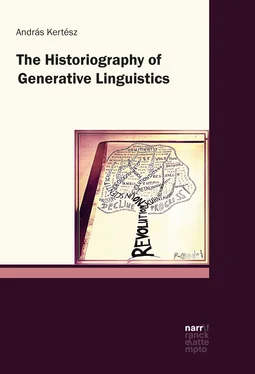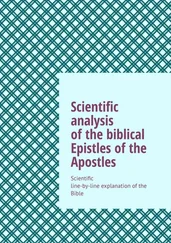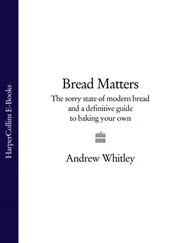
Figure 1
Second, it is KuhnKuhn, Thomas S.’s term ›scientificscientific revolutionrevolutionscientific‹ that provides the point of departure for the systematization. Figure 1 shows the main categories of the systematization with respect to this term. The categories, however, are to be understood in a more refined manner than the figure shows, because in the literature not all main categories are represented with respect to all Chomskyan publications mentioned in the previous paragraph. Moreover, the analysis of the literature will show that in the particular historiographicalhistoriography approaches the main categories should be subdivided into subcategories in different ways. Finally, the terminology is vague in many of the historiographical approaches (see also Section 3.1.3.4 on this).
The third criterion is that in the various sections we will discuss the different solutions to (P) by reconstructing their basic terms, their central hypotheses and the historiographicalhistoriography frameworks they apply.
The order in which we present the set of approaches that discuss the role of ChomskyChomsky, Noam’s different works in the context of the historyhistory of linguistics will be systematic, rather than chronological. The sections presenting the different solutions to (P) vary in length and detail, because the approaches are highly heterogeneous in terms of their genre, historiographicalhistoriography foundation, scope, and significance. We will provide a more extensive discussion of those approaches that present a sophisticated and refined description of the applied historiographical framework, or that have been widely debated.
2.1 ›Syntactic Structures Syntactic Structures ‹ (ChomskyChomsky, Noam 1957)
2.1.0 Background information
Basically, it is ChomskyChomsky, Noam’s (1957) Syntactic Structures Syntactic Structures that is considered to be the first seminal contribution to generative linguistics (but see footnote 1), although its text is rooted in his manuscript of 1955 entitled The Logical Structure of Linguistic Theory as well as in talks and papers.1 The main features of this work, which will be referred to in the next sections are as follows:
While BloomfieldianBloomfieldian and neo-Bloomfieldianneo-Bloomfieldian linguistics focused on phonologyphonology (in their terminology: phonemicsphonemics) and morphologymorphology, ChomskyChomsky, Noam’s approach centers on syntax .2
While for BloomfieldianBloomfieldian and neo-Bloomfieldianneo-Bloomfieldian linguists the main task was to reveal morphememorpheme classes based on distributionaldistributional properties, according to Syntactic Structures Syntactic Structures the goal of syntactic research is to construct a grammargrammar of a given languagelanguage that is capable of producing all the grammatically well-formed sentences, and only the grammatically well-formed ones.3
ChomskyChomsky, Noam introduces the distinction between ›grammaticalgrammatical‹ and ›ungrammaticalungrammatical‹ sentences.4
The grammargrammar is capable of generating an infiniteinfinite number of sentences from a finitefinite set of elements.5
In accordance with the Popperian trend of the analytical philosophy of sciencephilosophy of science, basically, grammars are to be conceived of as deductivedeductive theories characteristic of the natural sciencesciencenaturals, primarily physicsphysics.6
As opposed to BloomfieldianBloomfieldian and neo-Bloomfieldianneo-Bloomfieldian linguistics, Syntactic Structures Syntactic Structures assumes that there is no inductiveinductive procedure that facilitates the discovery of the correct grammargrammar. Instead, an evaluation procedureevaluation procedure is needed, the application of which may lead to the selection of the best grammar from possible candidates irrespective of how they were arrived at.7 From two alternative grammars the simpler one should be chosen.
The grammargrammar consists of three levels : phrase structurephrase structure, transformationstransformation and morphosyntax.8
The grammargrammar rests on a mathematicalmathematical foundation consisting of an algorithmicalgorithm formalism.9
Syntax is autonomous insofar as its rules are not determined by semantics.10
As we will demonstrate in the next sections, these features of Syntactic Structures Syntactic Structures have been interpreted and evaluated very differently by particular historiographicalhistoriography approaches.11
2.1.1 Revolution
2.1.1.1 KuhnianKuhnian revolutionrevolutionKuhnian
2.1.1.1.1 KuhnianKuhnian revolutionrevolutionKuhnian and the climate of opinionclimate of opinion
Since the second half of the 1960s, numerous works have been published which call Syntactic Structures Syntactic Structures ›revolutionaryrevolutionary‹ in KuhnKuhn, Thomas S.’s sense (ThorneThorne, James Peter 1965; LeiberLeiber, Justin 1975; YerginYergin, Daniel 1994 [1972]; SklarSklar, Robert 1994 [1968]; SearleSearle, John R. 1972; KoernerKoerner, E.F. Konrad 1978 [1972]; NewmeyerNewmeyer, Frederick J. 1986a; VidanovičVidanovič, Đorđe 2006 and others). To our knowledge, Thorne (1965: 74) was the first to claim explicitly that »[…] a revolution of the kind Kuhn describes has recently taken place in linguistics – dating from the publication of ChomskyChomsky, Noam’s Syntactic Structures in 1957«. Searle – drawing public attention to Chomsky’s personality and the significance of his early work – states in his famous article, which appeared in The New York Review of Books , that Chomsky’s
revolution followed fairly closely the general pattern described in Thomas KuhnKuhn, Thomas S.’s The Structure of Scientific Revolutions : the accepted model or ›paradigmparadigm‹ of linguistics was confronted, largely by ChomskyChomsky, Noam’s work, with increasing numbers of nagging counterexamples and recalcitrant datadata which the paradigm could not deal with. Eventually the counter-examples led Chomsky to break the old model altogether and to create a completely new one (SearleSearle, John R. 1972: 16).
SearleSearle, John R.’s article deserves special attention.1 If a widely-acclaimed scholar such as Searle who, as is well-known, represents significantly different views from those of ChomskyChomsky, Noam, acknowledges Chomsky’s work as revolutionaryrevolutionary and does so in a journal that is so widely read, then the public may consider his judgment reliable and this will effectively shape the reception of his work.2
In order to demonstrate an important circumstance for developing possible solutions to (P), now we will focus on KoernerKoerner, E.F. Konrad (1978) among the numerous contributions which claim that Syntactic Structures Syntactic Structures led to a new KuhnianKuhnian paradigmparadigm in linguistics. The reason why it is instructive to review Koerner’s approach is that later it went through numerous changes insofar as in several further papers Koerner considered other possibilities as well; therefore, his contribution to the discussions illustrates the plasticity and the vagueness of the term ›ChomskyChomsky, Noam’s revolution‹, as well as the complexity of the problems that it raises (see e.g. Koerner 2004: 2).
After analyzing the work of Schleicher, Saussure and ChomskyChomsky, Noam, KoernerKoerner, E.F. Konrad (1978) concludes that the conditions that enable us to talk about a KuhnianKuhnian paradigmparadigm are met in all three cases.3 Koerner’s thesis can be summarized as follows:
Читать дальше













